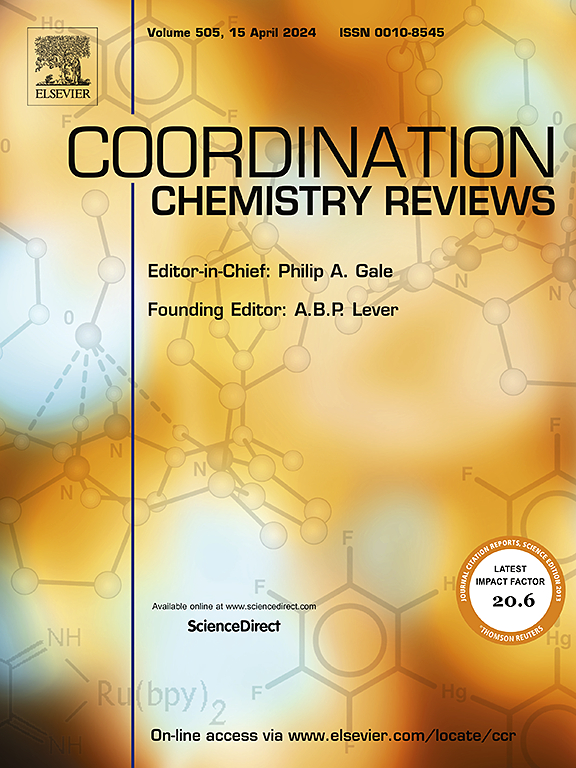基于纳米团簇的聚集体:组装形式、驱动力和结构相关性质
IF 20.3
1区 化学
Q1 CHEMISTRY, INORGANIC & NUCLEAR
引用次数: 0
摘要
原子精确纳米团簇由于其超小尺寸和强量子尺寸效应而受到广泛关注。这些纳米团簇具有独特和卓越的性能,使它们成为各种应用的优秀构建块。纳米团簇具有精确排列的结构,能够开发出具有增强特性的多功能纳米材料。由于其明确的分子组成,改进的稳定性和多功能,纳米团簇为通过自组装创建超结构提供了一个极好的平台。由表面配体和金属核之间的相互作用驱动的自组装过程是通知和增强我们对纳米团簇理解的关键方面。本文综述了近年来纳米团簇聚集的研究进展,特别是纳米团簇有序组装的超结构。我们重点研究了金属纳米团簇聚集背后的驱动力,包括配体-配体相互作用、金属-配体相互作用、金属-金属相互作用以及纳米团簇与其他粒子之间的相互作用。由纳米团簇组成的聚集体具有复杂的层次结构和增强的性能,为构建新型功能纳米团簇基材料铺平了道路。本文章由计算机程序翻译,如有差异,请以英文原文为准。

Nanocluster-based aggregates: Assembled forms, driving forces, and structure-related properties
Atomically precise nanoclusters have gained significant attention due to their ultra-small size and strong quantum-size effects. These nanoclusters possess unique and exceptional properties, making them excellent building blocks for various applications. With their precisely arranged structures, nanoclusters enable the development of multifunctional nanomaterials with enhanced characteristics. Owing to their well-defined molecular compositions, improved stability, and versatile functionalities, nanoclusters provide an excellent platform for creating superstructures through self-assembly. The self-assembly process, driven by the interactions between surface ligands and metal cores, is a key aspect that informs and enhances our understanding of nanoclusters. In this review, we summarized the recent progress of research on the aggregation of nanoclusters, especially their orderly assembled superstructures. We focus on the driving forces behind the aggregation of metal nanoclusters, including ligand-ligand interactions, metal-ligand interactions, metal-metal interactions, and interactions between nanoclusters and other particles. The aggregates, composed of nanoclusters, exhibit complex hierarchical structures and enhance performance, paving the way for the construction of novel functional nanocluster-based materials.
求助全文
通过发布文献求助,成功后即可免费获取论文全文。
去求助
来源期刊

Coordination Chemistry Reviews
化学-无机化学与核化学
CiteScore
34.30
自引率
5.30%
发文量
457
审稿时长
54 days
期刊介绍:
Coordination Chemistry Reviews offers rapid publication of review articles on current and significant topics in coordination chemistry, encompassing organometallic, supramolecular, theoretical, and bioinorganic chemistry. It also covers catalysis, materials chemistry, and metal-organic frameworks from a coordination chemistry perspective. Reviews summarize recent developments or discuss specific techniques, welcoming contributions from both established and emerging researchers.
The journal releases special issues on timely subjects, including those featuring contributions from specific regions or conferences. Occasional full-length book articles are also featured. Additionally, special volumes cover annual reviews of main group chemistry, transition metal group chemistry, and organometallic chemistry. These comprehensive reviews are vital resources for those engaged in coordination chemistry, further establishing Coordination Chemistry Reviews as a hub for insightful surveys in inorganic and physical inorganic chemistry.
 求助内容:
求助内容: 应助结果提醒方式:
应助结果提醒方式:


